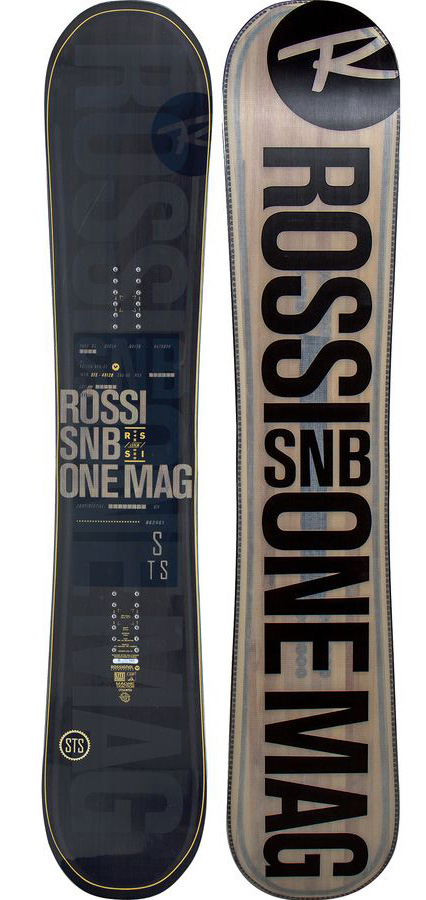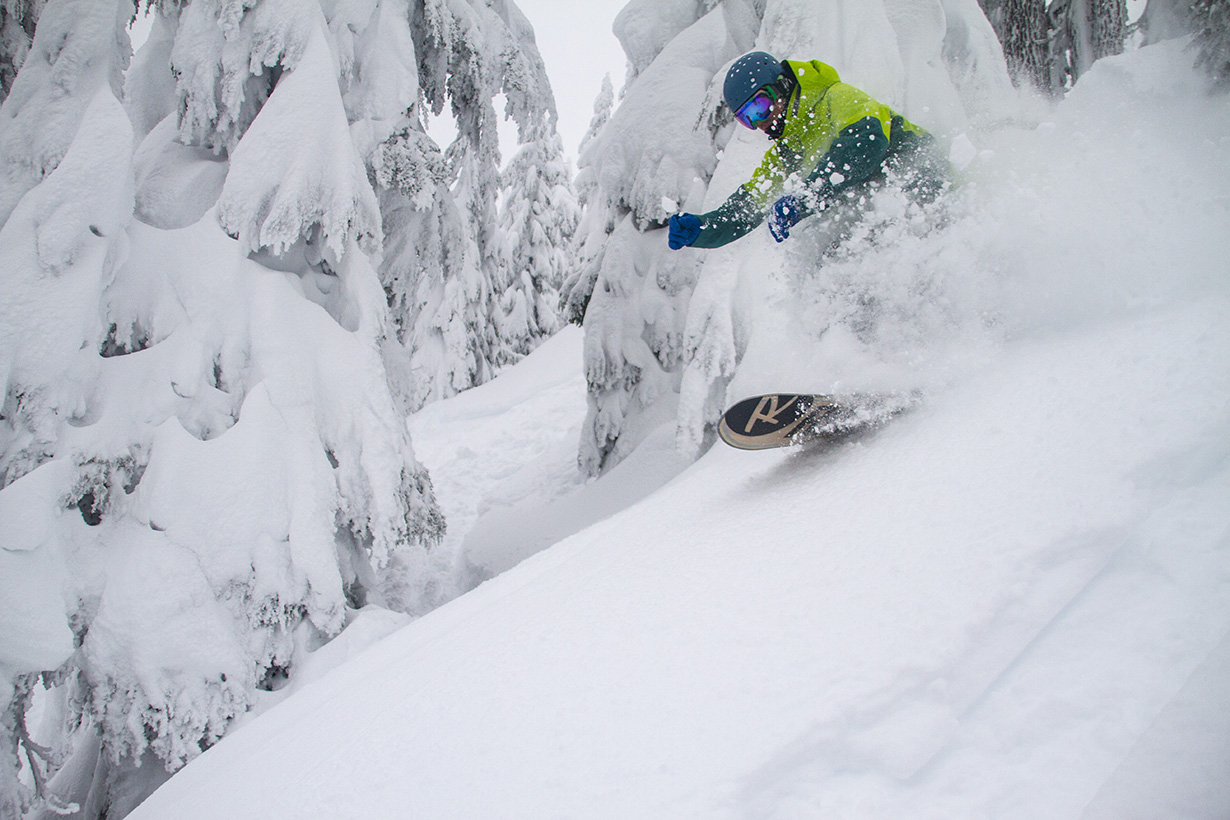
Board: 2016-2017 Rossignol One Magtek, 159 cm
Sizes (cm): 153 / 156 / 157 Wide / 159 / 161 Wide / 165 Wide
Camber: Amptek All Mountain (40% camber between the feet / 60% rocker at tip and tail)
Core: WOOD CBF1, Basalt, Kevlar
Flex: 7/10
Stated Features:
- Lite Frame- Urethane strips surround the core of the board for added shock absorption and better maneuverability.
- Magne-Traction 5S Sidecut – maximizes edge grip due to 5 bumps along the sidecut. The Magne-Traction bumps have been reduced by 50%, as well as removing 2 bumps outside of the binding zone to be more forgiving.
- Basalt, Aramid (kevlar), fiberglass and Thermoplastic Polyurethane (TPU) laminates designed to absorb vibration, increase torsional resistance and enhances the board’s stability while remaining relatively light.
- ABS reinforced sidewalls add durability and prolong the life of the board.
- 7500 Sintered Base
Blister’s Measured Weight: 3030 g / 6 lb 10.8 oz
MSRP: $499.95
Binding / Boots: Karakoram Prime Connect Binding / NOW Recon Binding / Nike Kaiju Boot
Test Locations: Mt. Bachelor, OR ; Alyeska Resort; Arctic Valley Ski Area, AK
Days Tested: 23
Introduction
As the name implies, the One Magtek is designed to be Rossignol’s best do-everything quiver killer.
I was specifically interested in the board for a week-long Mt. Bachelor trip with the Blister crew, since I was unsure of what the conditions and snowpack would be like for the trip. So I figured it would be the perfect occasion to test the One Magtek’s versatility, and to see how fun the board would be regardless of the conditions.
After a couple weeks of riding time, my biggest takeaway is that this board is not necessarily a great option for those who only want to charge down the mountain. It is, however, really fun in deep powder and on groomers, since it is an extremely snappy all-mountain freestyle board.
The One Magtek was my first experience riding a snowboard from Rossignol, and I must say that I have been impressed with the overall quality and construction of the board (since the base of the board is clear, it is relatively easy to inspect how well the board is laminated and constructed). After 20 + days of riding through ice, powder, and rocks, the board remains unscathed and just as lively as when I took it out of the box.
Profile and Flex
The One Magtek features 60% rocker at the tip and tail, and 40% camber underfoot. Rossignol designed the One Magtek with a directional flex that is stiffer near the waist and back foot (for control and added stability at higher speeds), with a slightly softer flex in the nose.
After just a couple runs on the board, I could really feel how soft the nose was in comparison to the tail. It took about an afternoon of tomahawking and getting thrown over the nose repeatedly before I felt like I had figured the board out and adjusted my riding style. Part of the issue was that I had been riding predominantly directional snowboards and splitboards in the months leading up to the Bachelor trip — the Jones Hovercraft, Jones Solution, Amplid Milligram, G3 Scapegoat — all of which are much stiffer, more directional, and mounted with more dramatic setback powder stances.
During those first few days getting used to the flex and camber of the One Magtek, I found myself wishing that (1) the nose was stiffer, (2) the mount pattern was set back more, and (3) the flex was stiffer between the bindings and through the tail. So to mitigate the tendency to get thrown over the nose, I mounted my bindings with a more directional stance, resulting in a longer nose and shorter tail, which seemed to match the camber profile much better.
After that adjustment period, I came to really love the profile and flex of the One Magtek. The soft nose no longer became an issue, and instead, the board became a really fun, dynamic platform to butter and spin off of. I still preffered to have a more directional, set back stance to help prevent getting pitched over the nose, but it doesn’t feel as critical as it did initially while getting used to the board. Long and short: if you’re coming from directional boards, I would recommend a more exaggerated set-back stance while getting acclimated to the One Magtek, especially when landing in deep powder or riding tracked out, higher density snow. And then you might adjust to a more centered stance to thoroughly enjoy the twin shape.

One-Board Quiver?
Rossignol rates the flex of the board as 7 out of 10, but it seems quite a bit softer than most all-mountain boards I’ve ridden. Generally to be a great one-board quiver killer (for my uses, at least), the board has to have a strong enough spine to plow through chunder and tracked-out snow at higher speeds.
More often than not, by the end of the day riding at Mt. Bachelor and Alyeska, I encounter bumpy, variable snow with tired legs. And in such conditions, additional stiffness would make plowing through the cut up or wet, heavy snow much easier, providing more stability. Perhaps the “wide” version of the One Magtek would provide a bit more inherent stability and be a better option for those who plan on charging the whole day at the resort.
But if the board feels a bit soft to be an all-mountain, all-conditions charger, its softer flex and snappiness makes it really fun to jib around on, take through the park, or to boost side hits all over the mountain.
Shape
Although the One Magtek has a slight set back stance of 13 mm, it has a true twin shape. One of the more impressive aspects of the shape is how well the board grips groomers and icy terrain. I have never had a board (magnetraction or not) grip and engage turns so easily on firm conditions.
The combination of the Radcut and Magne-Traction really digs deep into the snow and edges well when you need it the most. Rossignol’s says RadCut is “A traditional sidecut between the inserts that fuses with multiple reverse sidecuts toward the tip and tail, providing real-time sidecut adjustment to the ride.” This essentially feels like a longer effective edge at higher speeds, and shorter effective edge when going slower for more maneuverability. The more pronounced sidecut seems to deliver quicker, more responsive turns while smoother taper makes for a more fluid, relaxed ride.
The nose and tail profile of the board are slightly blunted, which helps it float well in powder and helps lengthens the effective edge of the board. I have not had any issues with the nose hooking or sinking in powder nor loss of control on groomers. Overall, the shape seems very well suited for a one-board-quiver ride.
NEXT: Performance, Powder, Etc.
